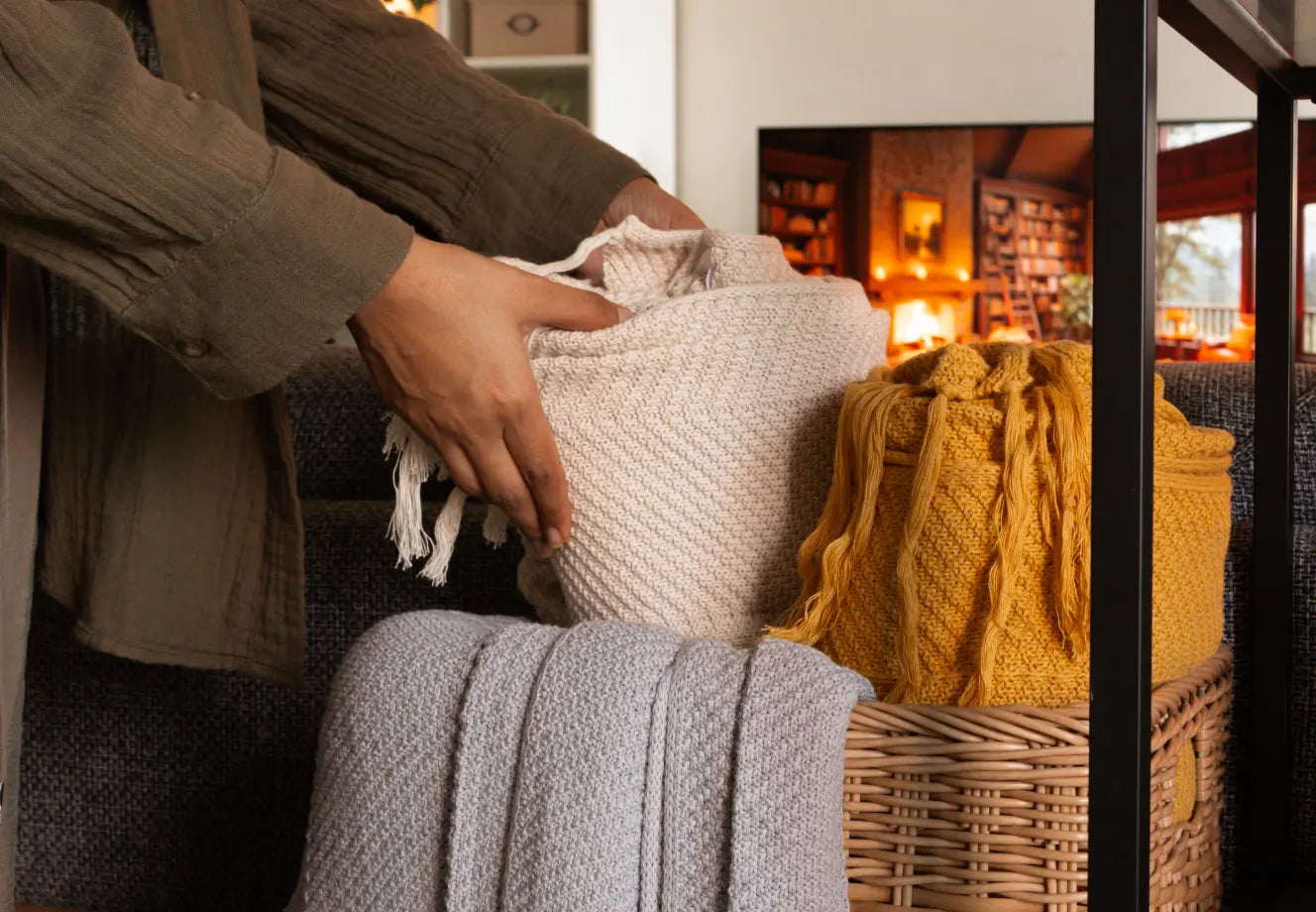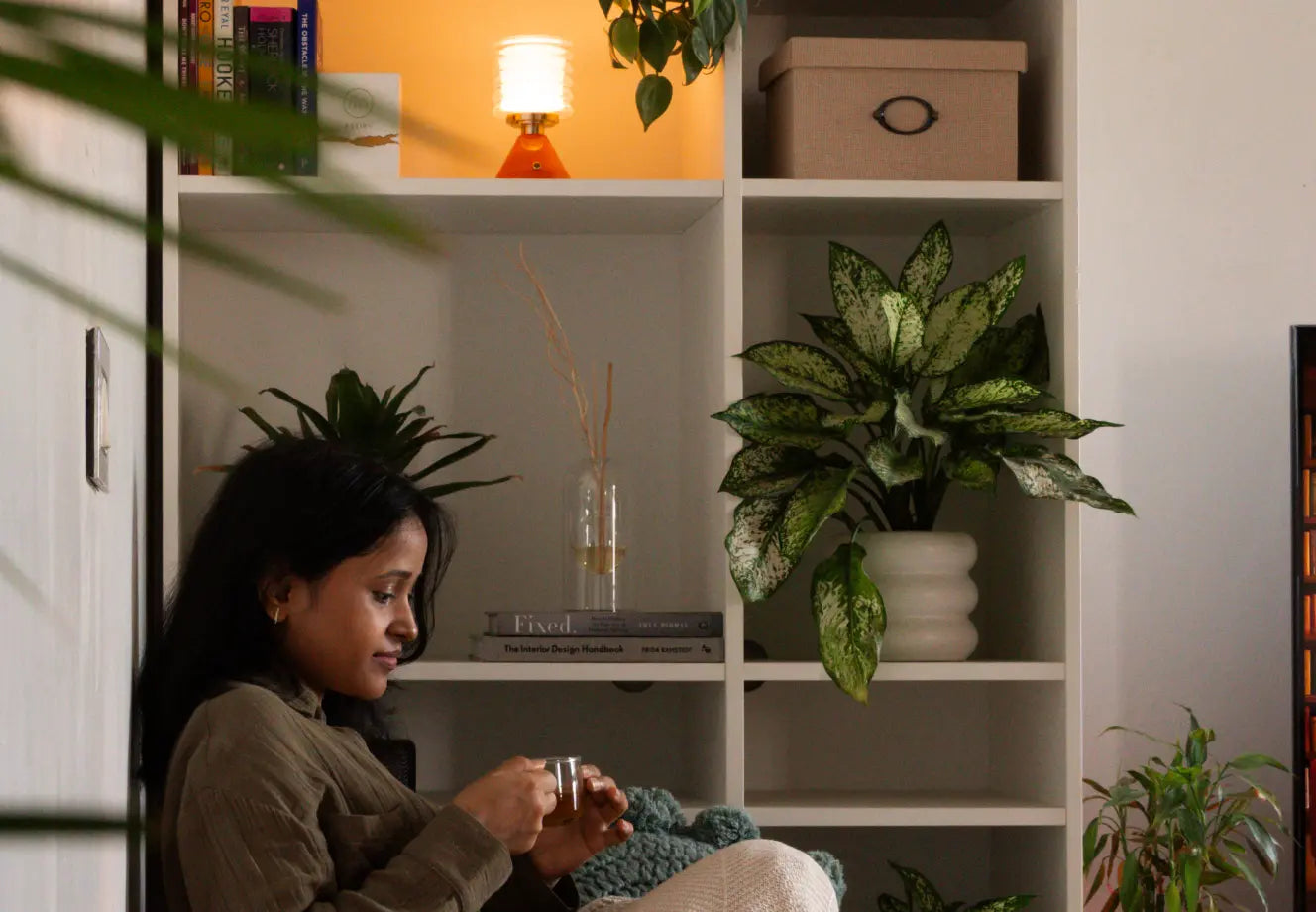A calm home is not an accident; it’s a series of intentional choices. Japandi home decor brings those choices into focus by blending the warmth of Scandinavian comfort with the quiet simplicity of Japanese design. This Japandi style feels calm, minimal, and cozy, with natural materials, soft light, and fewer, better pieces that reduce visual noise and make everyday living feel gentler, especially in busy, modern homes. If you’re drawn to light-filled rooms, low furniture, and soft, earthy textures, you’re already leaning toward Japandi.
In this guide, we’ll explore Japandi interior design in a clear, practical way so you can understand the style and apply it at home. At Gharko, we have seen how simple shifts such as a lower sofa, a neutral rug, a single ceramic vase, or a warmer lamp can transform how a room feels. You’ll find room-by-room ideas, material suggestions, and styling tips to help you create a premium yet relatable home that feels grounded, welcoming, and easy to live in every day.
What Is Japandi Style?
Japandi style is a gentle meeting point between Japanese and Scandinavian design, often described as a Japanese Scandinavian interior design approach. Think of it as a calm, edited way of living where every piece has a purpose and the room feels light, open, and easy to breathe in. Japandi home decor uses simple lines, natural materials, and soft, neutral colours to create spaces that feel warm, minimal, and welcoming, not bare. It is not about copying a perfect Pinterest image but about creating a home that feels quieter, more grounded, and easier to maintain in daily life.
At its heart, Japandi style values intention over excess. You keep what you use and love, choose materials that age well, and let in as much natural light as possible. The result is a home that looks serene but is also practical, comfortable, and very livable, whether you are in a compact apartment or a larger space.
The Japanese Side – Wabi-Sabi and Natural Calm
From Japan, Japandi home decor borrows the idea of wabi-sabi: finding beauty in things that are simple, imperfect, and shaped by time. Instead of glossy finishes and heavy ornament, you see soft edges, visible grain, and a slightly uneven glaze on a ceramic bowl or a wooden table that shows its knots and markings.
Materials tend to be honest and natural: wood, stone, clay, paper, linen, and bamboo. Colours are muted and earthy, helping the eye rest. Nothing feels overly polished or delicate; it is meant to be used and lived with. This creates a quiet, grounded energy at home.
When you embrace this side of Japandi style, you allow patina, texture, and small irregularities to tell a story, instead of constantly chasing the new.
The Scandinavian Side – Hygge and Everyday Comfort
From Scandinavia, Japandi interior design takes hygge, the feeling of everyday comfort and ease. Here, the focus is on how a room feels when you sit down after a long day: is it soft, warm, and inviting, or bright and restless?
Scandi influences show up in light-filled spaces, pale woods, simple silhouettes, and furniture that is practical and comfortable. Soft textiles play a big role: cushions, throws, wool or cotton rugs, and sheer curtains that move gently with the breeze. Lighting is layered and warm, using table lamps, floor lamps, and candles instead of one harsh ceiling light.
This side of Japandi style cares about how you actually live in the space, not just how it looks in photos. It asks small questions: Is the sofa cozy enough to curl up on? Is the dining area comfortable for long conversations? The goal is a home that supports your daily rituals.
East-Meets-West: How Japandi Interior Design Blends Both
When these two worlds meet, you get Japandi interior design: calm like a Japanese courtyard, cozy like a Scandinavian living room. Spaces are simple, but not empty. Rooms are warm but not crowded.
The blend shows up in “fewer but better” pieces. Instead of many small items, you choose one good table, one comfortable sofa, one beautiful lamp, and a few meaningful objects. The layout stays open and uncluttered so you can move easily and let light flow through. Natural materials from both traditions work together: light oak with darker walnut, linen with wool, ceramics with glass, and rattan.
This relaxed minimalism makes Japandi home decor ideal for modern homes, especially when life feels busy, and it shows how a few clear Japandi style elements can completely change how a space feels. It gives you a visual reset every time you walk in: less noise, more calm, and a style that feels timeless rather than trendy.
Key Principles of Japandi Interior Design
Think of these as simple rules of thumb for any Japandi home. Whether you’re working on one corner or an entire apartment, these ideas help you bring Japandi interior design to life in a calm, practical way. When you keep them in mind, Japandi style feels less like a trend and more like a gentle framework for every choice you make.
1. Simplicity and Function First
Japandi home decor starts with how you live, not just how things look.
- Clean lines, clear floors, uncluttered surfaces
-
- Keep furniture shapes simple and avoid heavy ornamentation.
- Leave space around pieces so rooms feel open and easy to move through.
- Layouts that support how you move, work, and rest
-
- Position seating where you naturally sit, read or talk.
- Keep pathways wide and free from obstacles.
- Storage that hides visual noise
-
- Use closed cabinets, baskets, and trunks to tuck away everyday clutter.
- Store rarely used items out of sight so key surfaces stay calm and clear.
2. Fewer But Better Pieces
In Japandi style, you don’t need a lot of furniture; you need the right furniture.
- Invest in solid, timeless furniture instead of many small items
-
- Choose well-made sofas, tables, and chairs that will last for years.
- Choose pieces that work across rooms and seasons
-
- A neutral armchair or wooden bench can move from living room to bedroom as your needs change.
- Let one or two anchors take the lead
-
- Allow a beautiful sofa, dining table, or lamp to be the quiet hero of the room.
- Keep the rest of the decor simple so these anchors can breathe.
3. Natural Materials and Rich Textures
Japandi interior design feels warm and grounded because it leans heavily on honest, tactile materials.
- Use a calm mix of natural materials
-
- Wood, linen, cotton, wool, stone, ceramics, rattan, and paper all sit beautifully together.
- Mix textures for depth instead of relying on busy patterns
-
- Pair a smooth wooden table with a nubby rug, soft cushions, and a matte ceramic vase.
- Prioritise surfaces that feel good to touch
-
- Think of the softness of a throw, the warmth of timber underfoot, and the coolness of stone.
- These small, sensory details make Japandi home decor and Japandi interior decor feel quietly luxurious.
4. Soft Neutrals with Gentle Contrast
Japandi style colour palettes are calm, neutral, and layered, never flat or stark.
- Start with a light Scandinavian base
-
- Whites, creams, beiges, and pale woods keep spaces bright and airy.
- Add darker Japanese accents
-
- Use charcoal, walnut, black, or deep brown in smaller doses: frames, legs, lamps, and trays.
- Aim for gentle contrast, not sharp edges
-
- Avoid harsh black-and-white combinations.
- Instead, let tones fade softly into each other so the eye moves smoothly around the room.
5. Connection to Nature
A Japandi home always feels close to nature, even in the middle of a city.
- Bring in greenery and natural elements
-
- Use indoor plants, branches in a vase, or simple seasonal foliage as quiet focal points. Japandi greenery, from soft indoor plants to minimal planters, keeps the space feeling alive without visual clutter.
- Let natural light lead the space
-
- Keep windows as clear as possible, and use sheer curtains to soften, not block, the daylight.
- Soften straight lines with organic shapes
-
- Curved vases, rounded tables, imperfect ceramics, and wavy trays help balance all the straight edges.
- This mix of structure and softness is what makes Japandi interior design feel both calm and alive.
Getting Started: How to Plan Your Japandi Home
Planning a Japandi home is much easier when you move in small, thoughtful steps. Instead of buying everything new, you’ll edit what you already own and understand how your home behaves through the day.
Once you see what is working and what feels heavy, you can start layering in Japandi style choices with intention. These four steps give you a simple, clear roadmap, whether you are redoing one room or slowly guiding your entire home toward Japandi interior design and your own Japandi decor ideas.
1. Declutter and Edit What You Own
Japandi home decor always starts with subtraction, not shopping. Begin by sorting what you already have: keep what you use and love, donate or sell what you’ve outgrown, and store seasonal or sentimental pieces out of sight.
Clear key surfaces first, such as coffee tables, sideboards, and bedside tables. Then free up floor space so the room can breathe and the furniture has a little space around it.
If the idea of decluttering the whole home feels overwhelming, choose one corner, one shelf, or one room and finish it completely. That small win will set the tone for the rest of your Japandi journey.
2. Study Your Light and Layout
Before choosing furniture or decor, spend a day watching how your home behaves. Notice where natural light falls in the morning, afternoon, and evening, and which walls or corners feel flat or shadowed.
Pay attention to how you walk through each room: where you pause, where you squeeze past things, where bags and mail naturally land. These are your layout clues.
Japandi interior design works best when you respect these patterns by keeping pathways open, placing seating where light is soft, and using lamps to gently lift darker corners that can’t be fixed by rearranging alone.
3. Choose a Calm Japandi Colour Palette
A Japandi home feels calm partly because the colours are simple and repeated. Start by choosing two or three base tones, such as warm white, soft beige, and light wood, and one or two accent shades like charcoal, muted green, or warm taupe.
For a cozy, grounded feel, lean into warmer neutrals. For a fresher mood, add cooler greys or soft stone. Keep this palette consistent across rooms so the home feels connected rather than fragmented.
When in doubt, choose less colour but more texture. This is a quiet secret of successful Japandi home decor.
4. Decide Your Balance: More Japanese or More Scandi?
Every Japandi style home sits somewhere on a spectrum between Japanese and Scandinavian influences. If your space gets plenty of light and you love a grounded, cocoon-like feel, you can lean more Japanese with deeper woods, earthy tones, and stronger black accents.
If your home is compact or a bit dark, leaning more Scandi with pale woods, lighter fabric, and airy curtains will keep it feeling open. Lighter bases and softer fabrics help rooms feel less cramped.
There is no single “correct” mix. Adjust based on your home’s size, natural light, and lifestyle, and let Japandi interior design flex around you, not the other way round.
Final Thought: Japandi as a Mindset, Not Just a Trend
Japandi style is more than a look that appears for a season and disappears. It is a mindset that values calm, simplicity, and nature-led, intentional choices. When you lean into Japandi home decor, you are not chasing perfection; you are creating minimal, calm interiors shaped by a gentle mix of wabi-sabi, hygge and everyday comfort. A few thoughtful decisions about colour, layout, and materials can gently change how your home feels and how you feel inside it.
You do not need to transform everything at once. Start with the planning steps, then make one small change, such as clearing a surface, softening a light, or adding a single ceramic vase with greenery. At Gharko, we believe Japandi interior design should feel achievable, not overwhelming, and we are here to guide you with ideas, products, and inspiration that support a calm, modern home. In the next part of this guide, we will walk through Japandi room by room so you can gently apply this style across your entire home.
















